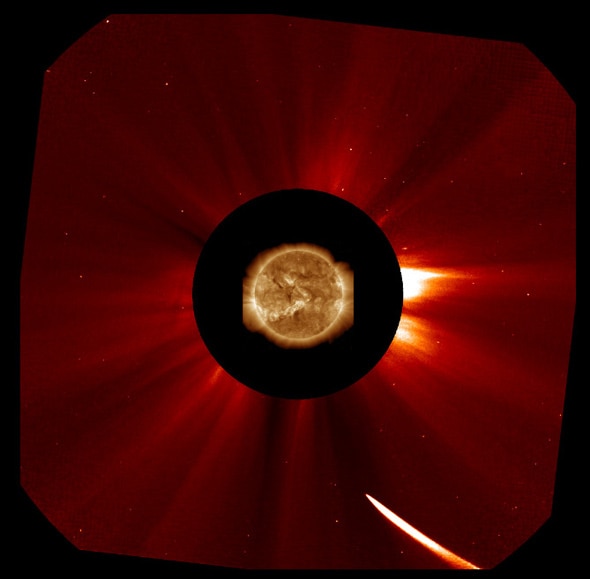Create a free profile to get unlimited access to exclusive videos, sweepstakes, and more!
Quick ISON Update: Dimmed but Still Rocking

A quick update on Comet ISON: It brightened quite a bit last night, and then started dimming. Itâs still going strong, but itâs unclear exactly whatâs happening to the comet itself.
Hereâs a shot taken by the SOHO satellite that shows ISON as of Thursday, Nov. 28 at 15:34 UTC (10:34 EST):
As you can see itâs still pretty bright, but it was far brighter a few hours earlier. Remember, comets are rocks, gravel, and dust held together by ice. When the ice warms, it turns into a gas, creating the fuzzy coma and long tail. That gas and dust reflect sunlight and make the comet bright.
Here's a wider field view, also from SOHO:
The tail is pretty impressive! But it's definitely dimmer than it was last night.
Itâs possible that the brightening earlier was due to a pocket of gas erupting. Itâs also possible the brightening was normal (it is getting closer to the Sun after all!) and for some reason the supply of ice turning into gas got choked off. It could also be that the solid nucleus of the comet disrupted, making it very bright for a short time, and then starting to fade.
Thereâs no real way to know right now. Iâm seeing lots of speculative chatter in various places, but nothing definitive. Â
Iâll note the comet is close enough to the Sun that the rock on the surface is hot enough to vaporize, so the physical situation near the nucleus is complicated.
It reaches perihelion (closest point to the Sun) at about 18:37 UTC (1:37 EST) today, when it will be about 1.1 million km (700,000 miles) above the Sunâs surface, and moving at better than 360 kilometers per second (225 miles/second).
Iâll have more info soon. And donât forget, Iâll be participating in the NASA live Google+ Hangout which starst at 18:00 UTC (1:00 p.m. EST). Iâll have the video feed embedded in a blog post here. Stay Tuned!


























